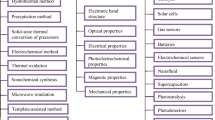Abstract
Present study describes the synthesis and characterization of copper octoate. Attenuated total reflectance–Fourier transformation infra red (ATR–FTIR) and energy dispersive X-ray (EDX) spectrometric techniques have been used for the characterization of the synthesized compound. The surface morphology of the compound has been studied using scanning electron microscopy (SEM). Thermal behavior and decomposition mechanism of copper octoate has been explained on the basis of simultaneous thermo-gravimetry–differential thermal analysis–evolved gas analysis (TG–DTA–EGA) and high temperature X-ray diffraction (HTXRD) measurements. Copper octoate is stable up to 250 °C. The decomposition process consists of two overlapping steps. A plausible decomposition mechanism is proposed and details of the studies carried out are being discussed here.








Similar content being viewed by others
References
van Gorkum R, Bouwman E. Alkyd paint and paint driers. Coord Chem Rev. 2005;249:1709–28.
Parker DH. Principles of surface coating technology. New York: Wiley; 1965. p. 228–40.
Payne HF. Organic coating technology, vol. 1. New York: Wiley; 1954. p. 227–40.
Paint Technology Manuals. Oil and colour chemists association, vol. 2. New York: Reinhold Publishing Corporation; 1961. p. 31–57.
Negishi A. Thermoanalytical investigations of yttrium barium copper oxide superconductor. Thermochim Acta. 1989;140:41–8.
Nasu H. Superconducting Y–Ba–Cu–O films with Tc > 70 K, prepared by thermal decomposition technique of Y-, Ba-, and Cu-2-ethylhexanoates. Chem Lett Chem Soc Japan. 1987; 26:2403–2404.
Nasu H. Barium yttrium copper oxide films with Tc > 70 K, prepared by the pyrolysis of 2-ethylhexanoates. J Mater Sci Lett. 1988;7/8:858–60.
Yazdanbaksh M, Khosravi I, Tavakkoli H. Synthesis and characterization of novel oxo-bridged, trinuclear mixed-metal complexes of Cr(III) and Fe(III). J Serb Chem Soc. 2009;74(4):401–6.
Li QF, Kun L, Yang QQ, Jin R. The effect of different metallic catalysts on the coreaction of cyanate/epoxy. J Appl Polym Sci. 2006;100:2293–302.
Chache P, Raje N, Naik V. Synthesis and characterization of copper octoate. In: Proceedings of 12th European conference on solid state chemistry, ECSSC, XII SSC 145, 230, September 2009. Munster: University of Munster.
van der Weerd J. 5 FTIR studies of the effect of pigments in the ageing of oil in Microspectroscopic analysis of traditional oil. Amsterdam: UvA-DARE, the institutional repository of the University of Amsterdam (UvA); 2002. p. 74. http://dare.uva.nl/document/85900.
Dresseyn HO. Vibrational analysis of acid derivatives. In: Patai S, editor. The chemistry of acid derivatives: the chemistry of functional groups, vol. 2. Chichester: Wiley; 1992. p. 271–304.
Mehrotra RC, Bohra R. Metal carboxylates. London: Academic Press; 1983. p. 83–5.
Palacios EG, Juárez-López G, Monhemius AJ. Infrared spectroscopy of metal carboxylates II. Analysis of Fe(III), Ni and Zn carboxylate solutions. Hydrometallurgy. 2004;72:139–48.
Pratt HD III, Rose AJ, Staiger CL, Ingersoll D, Anderson TM. Synthesis and characterization of ionic liquids containing copper, manganese, or zinc coordination cations. Dalton Trans. 2011;40:1140–396.
Gross ME, Gallagher PK, Brown WL. Superconducting thin films and ion beam patterning using metal carboxylate precursors. Solid State Ionics. 1989;32/33:1051–5.
Bruker EPA–NIST IR library. 5211 Spectra G5. Ettlingen: Bruker Optik GmbH; 2003.
Yang J-G, Yang S-H, Tang C-B, Jing HE, Tang M-T. Synthesis of ultrafine copper particles by complex–reduction–extraction method. Trans Nonferrous Met Soc China. 2007;17:S 1181–5.
Grass RN, Stark WJ. Gas phase synthesis of fcc-cobalt nanoparticles. J Mater Chem. 2006;16:1825–30.
Olah GA. 100 Years of carbocations and their significance in chemistry. J Org Chem. 2001;66:5944–57.
Acknowledgements
Authors wish to thank Dr. A.K. Tyagi, Chemistry Division, BARC for providing HTXRD data. Also we wish to acknowledge Dr. C.G.S. Pillai and Shri Jitendra Nuwad, Chemistry Division, BARC for their support and help in carrying out SEM–EDX measurements.
Author information
Authors and Affiliations
Corresponding author
Rights and permissions
About this article
Cite this article
Raje, N., Naik, V.R. & Reddy, A.V.R. Thermal decomposition mechanism of synthesized copper octoate. J Therm Anal Calorim 112, 187–192 (2013). https://doi.org/10.1007/s10973-012-2748-x
Received:
Accepted:
Published:
Issue Date:
DOI: https://doi.org/10.1007/s10973-012-2748-x




